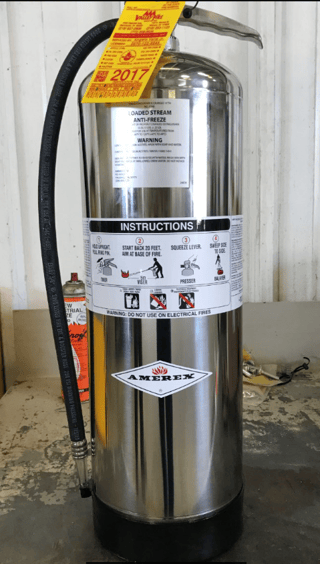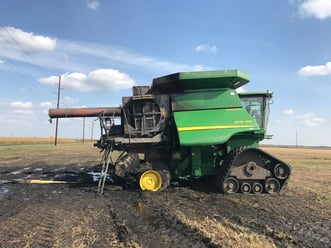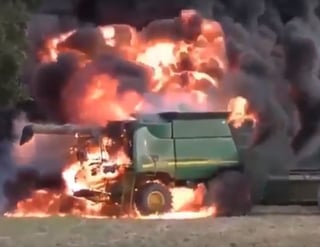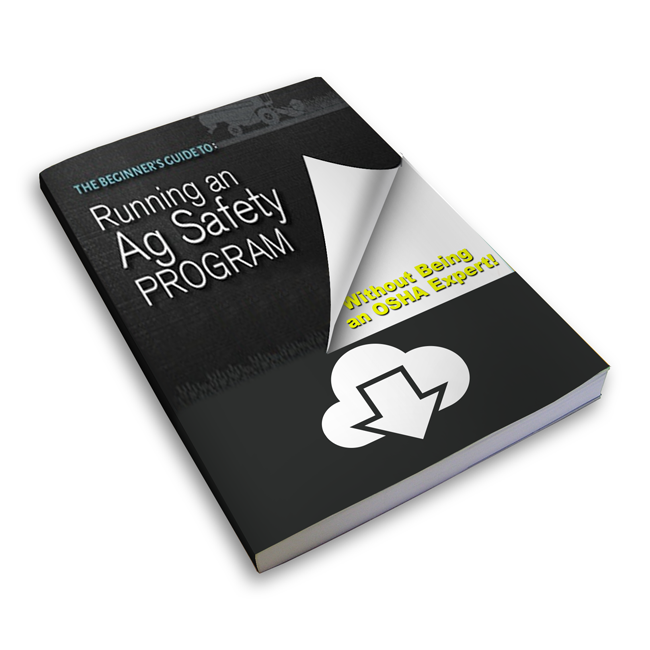Combines have been rolling throughout the Midwest through mostly very dry conditions. Clouds of dust can be seen for miles where combines have been. These dry, dusty conditions also make it ideal for combine fires. One component in fire protection I’d like to cover is the pressurized water extinguishers. Though normally seen on balers, we also see them on combines.
Let’s examine the use of the 2.5 gallon pressurized water extinguisher.

Water extinguishers extinguish the fire by taking away the heat element of the fire triangle (oxygen, fuel and heat/ignition source, see Sept. 12 blog). They are essentially tanks full of water with compressed air to force the water out. Water extinguishers are used only on type A fires, such as wood, cloth, paper, and any material that will burn to an ash.
How long do water extinguishers last as compared to ABC type fire extinguishers?
Rule of thumb is to estimate a water extinguisher to last 20 seconds for every gallon of water or 50 seconds. Dry chemical extinguishers last about 1 second for every pound of dry chemical in the extinguisher. Expect a 10 lb. ABC extinguisher to last about 10 seconds.
How far is the reach of a water extinguisher as compared to ABC type fire extinguishers?
The horizontal range of the pressurized water stream will reach the distance of 30 to 55 feet. The horizontal range for a typical ABC dry chemical extinguisher is 5 to 20 feet.
How does the water extinguisher put out a fire as compared to the ABC type fire extinguishers?
The water effectively puts out the fire by cooling the fuel (burning materials, dust and harvest debris) to the point below the temperature at which the fire can continue to burn or reignite. The dry chemical works by blanketing or coating the fuel and interrupting the chemical chain reaction at the fuel’s surface. It separates the fuel from the oxygen in the air.
.jpg?width=320&name=IMG_3430%20(2).jpg)
.jpg?width=320&name=IMG_3432%20(2).jpg)
What can a water extinguisher be used for?
The first step in fighting any fire is to determine what is burning says Dr. Bill Field, Professor in Agricultural and Biological Engineering at Purdue University. Water extinguishers are used only on type A fires. On combines it’s common for the fuel source to be dust, chaff and other combustible harvest debris especially around the engine compartment. However, the fuel source can also be from fuel, hydraulic oil, grease or it could be from energized electical equipment (type b and c fires).
What are the pros for using a 2.5 gallon water fire extinguishers?
Water extinguishers utilize the cooling, soaking and penetrating effect of a 30 to 55 ft. stream of water for type A fires. Especially for inexperienced operators, these extinguishers allow for visibility during discharge with a discharge time of roughly 1 minute. An authorized fire extinguisher service can protect the extinguisher from freezing by adding an antifreeze charge. Water extinguishers are easily distinguishable as they are silver and not red.


Closing Thoughts
It will be more important this dry fall to strictly adhere to an elevated service, maintenance and cleaning schedule to prevent a combine fire thoughout harvest. Carry at least two fire extinguishers on the combine, one should be an ABC type extinguisher. As soon as the fire is noticed, pull the combine away from the crop, call 911 before you attempt to extinguish the fire. Determine what is burning to know whether to use an ABC or water type extinguisher. All vehicles should carry sizable ABC fire extinguishers not only for the vehicle itself but for back up when one or two extinguishers are not enough.
Take time to train employees on fire fighting and extinguisher use. Response time is critical to getting a small fire under control. Not having experience could use up precious time, discharge the contents too quickly and be ineffective at putting the fire out. Training can save the combine, crop and assure everyone Get Home Safe.



